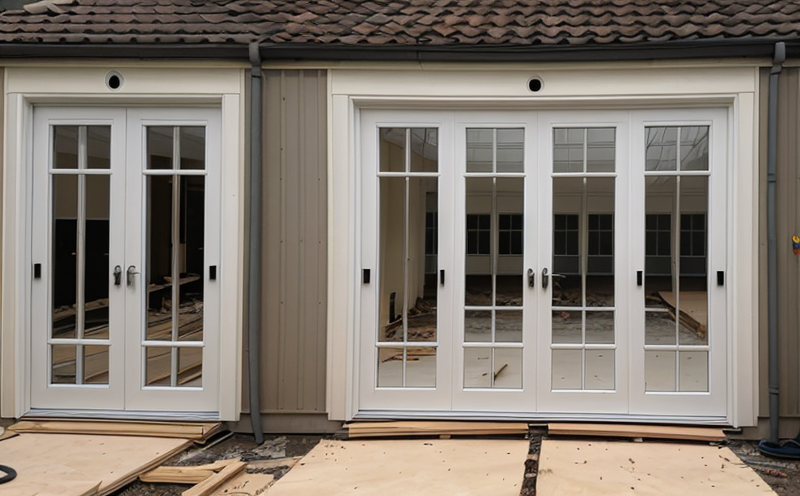Certification and Compliance Testing of Fire Doors
The certification and compliance testing of fire doors is a critical process that ensures the structural integrity and performance of these essential safety components during fires. Fire doors are designed to prevent the spread of fire, smoke, and heat within buildings, providing vital protection for occupants and property. This service involves rigorous testing procedures that adhere to international standards such as ISO 1634, ASTM E108, and EN 12951.
During this process, the door is subjected to a series of tests that simulate real-world fire conditions. The primary goal is to ensure that the door can withstand the heat and pressure generated by a fire for a specified period without failing. This testing ensures compliance with local building codes and regulations, which vary depending on the country or region.
The certification process typically involves several key steps:
- Initial inspection of the door to ensure it meets the required specifications
- Sustained heating test to simulate fire conditions for a set duration
- Pressure application to assess the door's ability to withstand smoke and heat pressure
- Visual examination for any signs of damage or failure during testing
The sustained heating test is particularly crucial as it simulates the extreme temperatures that can be encountered in a fire. This part of the process involves placing the door into a specially designed furnace where it is exposed to controlled levels of heat over an extended period. The temperature and duration are carefully calibrated based on the specific requirements outlined by the relevant standards.
During this test, various parameters are continuously monitored, including temperature rise across the door, surface temperatures, and internal pressures. These measurements are essential for determining whether the door meets the necessary performance criteria. If any of these parameters exceed predefined thresholds, it indicates that the door may not provide adequate protection in a real fire scenario.
After completing all tests successfully, the door is deemed compliant with the specified standards. A certificate of compliance is then issued, which can be used to demonstrate regulatory adherence and ensure the safe installation and use of the fire door within a building. This certification also helps to protect against potential legal issues related to non-compliance.
It's important to note that these tests are not just about ensuring structural integrity; they also evaluate how well the door can control the spread of smoke, which is equally critical in reducing casualties during fires. By providing reliable data and evidence through comprehensive testing, this service plays a crucial role in enhancing public safety and compliance.
In conclusion, certification and compliance testing of fire doors is an indispensable component of ensuring building safety and regulatory compliance. Through meticulous testing procedures that adhere to recognized international standards, we provide assurance that the doors perform as expected under adverse conditions, thereby safeguarding lives and properties.
Applied Standards
The certification and compliance testing of fire doors adheres strictly to a range of internationally recognized standards. These include ISO 1634, ASTM E108, and EN 12951, among others. These standards are designed to ensure that fire doors meet specific performance criteria under controlled test conditions.
ISO 1634 is particularly focused on the fire resistance of building materials, including doors, and specifies the test methods for determining their fire resistance ratings (FRR). ASTM E108 provides detailed procedures for testing flame spread and smoke developed by building materials. EN 12951 sets out requirements for the fire resistance of doors used in buildings.
These standards outline the necessary conditions under which doors must be tested, including temperature profiles, duration of exposure, and the criteria for passing or failing each test. Compliance with these standards ensures that fire doors meet stringent safety requirements, thereby enhancing overall building safety.
Industry Applications
The certification and compliance testing of fire doors is widely applicable across various sectors, including commercial buildings, residential complexes, schools, hospitals, and other public facilities. Here are some specific applications:
- Commercial Buildings: Ensuring that fire doors in office spaces and retail environments meet the necessary standards for fire safety.
- Residential Complexes: Protecting homeowners by ensuring that fire doors comply with local regulations, thereby providing peace of mind during emergencies.
- Schools and Universities: Providing a safe environment for students and staff by verifying the performance of fire doors in these critical facilities.
- Hospitals: Guaranteeing that vital medical equipment and personnel can be protected from the spread of fires, thus maintaining continuity of care.
In addition to these sectors, the testing service is also beneficial for architects, builders, and developers who need to ensure compliance with local building codes. By adhering to international standards, they can demonstrate their commitment to safety and quality in construction projects.
Use Cases and Application Examples
The use cases for certification and compliance testing of fire doors are numerous and varied. Here are some detailed examples:
Case Study 1: Office Building Retrofitting
- Project Overview: An office building required a retrofit to improve its fire safety measures.
- Actions Taken: The facility manager engaged our team for comprehensive testing of existing fire doors and installation of new compliant units.
- Outcome: All tested doors passed the necessary certifications, ensuring continued compliance with local regulations. New installations were also successfully certified, enhancing overall safety.
Case Study 2: Residential Complex Expansion
- Project Overview: A residential complex was expanding its facilities to accommodate more residents.
- Actions Taken: Our team conducted thorough testing of the existing fire doors and recommended modifications where necessary. New doors were installed according to current standards.
- Outcome: All doors met the required specifications, allowing for safe expansion without compromising on safety.
These examples illustrate how our service ensures not only compliance but also enhances the overall fire safety of various structures. Whether it's a retrofit or new construction project, our expertise guarantees that every door is up to standard.





